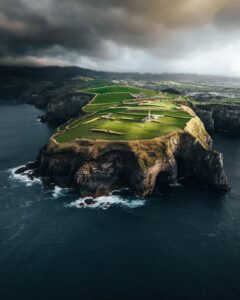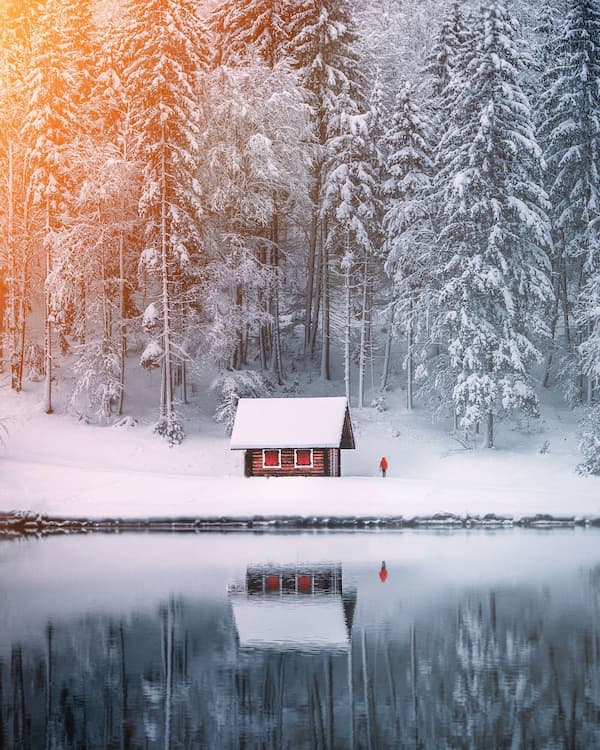
Photo tour in Azores, Portugal
Join us in the Azores for a unique photo tour, where you’ll elevate your creative skills with expert guidance from Ronald Soethje, Bruno Ázera, and Nomadict.
Anton König won our weekly contest – Week 5 – thanks to your votes. In this article, we learn about his passion for photography, his creative workflow shooting on location, and the post-production techniques and steps that helped him achieve one of his most celebrated images to this day.
A decade ago, my journey in photography began during my Work & Holiday year in Australia. At that time, I was not particularly interested in photography and merely took pictures of popular tourist attractions like any other sightseer. My Canon PowerShot S110, a basic digital camera, sufficed for my needs back then, and I was content with the quality of my shots, which in hindsight, were quite limited.
However, as I continued to travel, I started seeking inspiration and exploring interesting locations on social media platforms. The stunning images that I came across aroused a desire within me to capture such breathtaking pictures myself. To achieve this, I purchased a Nikon D5500 to enhance the quality of my pictures and to have more options that suited my travel requirements.
During my travels, I experimented with different cameras and compared their performance in various situations, including action, landscape, and portrait photography. The creative process of capturing images was an enjoyable experience for me, as I was always amazed by the results and the imaginative possibilities that arose during my shoots.
It wasn’t until I visited Ireland for the first time that my love for outdoor and landscape photography blossomed. The country’s stunning scenery served as my inspiration, driving me to capture its beauty in a way that was true to my vision and emotions.
My current occupation as a visual merchandiser was a key factor in my journey toward photography. I was initially drawn to the job because of its creativity and flexibility but soon realized that it wouldn’t allow me to fully express my creativity.
To balance my job and my passion for photography, I make it a point to travel often. Spending time outdoors is crucial for achieving the stunning results I desire. When I’m immersed in nature and capture something that really moves me, I feel a deep sense of connection to the earth. Travel photography has also taught me to be more mindful of my impact on the planet, and has inspired me to be a more responsible global citizen.
Over the past 7 years, my photography journey has been filled with valuable lessons:
1) As a lover of travel and photography, I had to learn how to prioritize my spending to afford both my dream destinations and the necessary equipment. I feel fortunate for the financial opportunities that have allowed me to experience so much.
2) Social media has played a significant role in building my confidence too, both personally and professionally. Through sharing my work and receiving feedback, I have been able to express my creativity in ways that were previously unavailable to me. This has helped me to develop my unique style and inspire others along the way.
3) When it comes to travel, I have discovered the importance of choosing the right destinations. Rather than sticking to the most popular tourist spots, I prefer to venture off the beaten path and explore less-frequented countries. Some of my most unforgettable experiences have been on road trips through Albania and Georgia, and these destinations have also provided excellent opportunities for my photography.
4) The fourth lesson I’ve learned in landscape photography is to exercise patience. It’s crucial to be in the right place at the right time, but that perfect timing often requires multiple attempts. One of the most valuable skills I’ve honed as a photographer is the willingness to invest time and try new things. By spending more time outdoors and exploring different conditions, I’ve been able to capture some truly incredible shots.
During my December round trip to the Dolomites, I made a detour to the province of Udine where I came across the mesmerizing Laghi di Fusine in the Julian Alps. My photo showcases the two glacial lakes, Lago di Fusine Inferiore and Lago di Fusine Superiore, connected by an easy path that leads through the forest. These lakes are situated at the foot of the Mangart massif in the Julian Alps and are also known as Belopeška Jezera due to their proximity to the Italy-Slovenia border. Despite its relative obscurity on Instagram, I was drawn to the lakes because of the many unique viewpoints it offers, which is particularly exciting for photographers. But what caught my attention was the lone cabin on the lakeside, which inspired me to envision and capture the perfect photo.
Upon arriving, I was overwhelmed by the serenity of the place and the joy of having it all to myself.

In winter, the colors in the scenery are strikingly vivid. The water has a unique green glow beneath the ice, while the frost and snow on the vegetation add a sparkling effect to the landscape. Fortunately, the water in my photo wasn’t frozen, which enhanced the reflection of the house on the lake.
Although I was slightly disappointed to discover that the isolated cabin in the woods was just a restroom, I still found the small house charming.
In terms of editing, I strive for consistency in color and lighting across all the pictures I post. I view photography as the inverse of painting. While painters begin with an empty canvas and gradually add to it, photographers must eliminate extraneous elements from a complex scene to distill it down to its essential components. These elements must then be arranged in a compelling composition:
1) When composing a photo, I pay close attention to the placement of the horizon line. Following the “rule of thirds” concept, I aim to emphasize the most intriguing part of the photograph.
2) I utilize programs such as Lightroom and Photoshop, and apps such as Snapseed and VSCO.
3) After opening the raw image in Photoshop, I typically adjust the contrast, saturation levels, and sharpening, and proceed with selective dodging and burning.
4) I aimed to give my final result a distinctive look by enhancing the contrast of the sun rays with the selective tool in Snapseed.
5) I employed the Ambience tool to balance the light.
6) And to draw attention to the cabin, I intentionally increased the saturation of the reddish tones.
7) The most crucial step in my editing process was to ensure a flawless reflection of the image. To keep it authentic, I used the selective tool from the Snapseed app to smoothen the water surface without affecting the mirrored objects.
Reflective images are always captivating. The more polished and clear the reflection appears, the more impressive it is. Interestingly, I learned a new technique in image editing while creating this photo, which involves softening the reflective water.
Move RIGHT or LEFT to compare
My four important ingredients for a great landscape photo are:
1) Importance of Good Lighting
Good lighting is essential in landscape photography. For beginners, learning to use light is often the most challenging aspect of photography. It can be more challenging to explain and take longer to learn than photography techniques. However, lighting is crucial for creating captivating photographs. Proper lighting results in vibrant colors, excellent depth, dramatic contrasts, and a three-dimensional effect that captivates the viewer’s attention.
2) Identify a clear main subject in your shot.
This may seem like an obvious step, but it is crucial to consider what you want to showcase in your photograph. When capturing a landscape, I always ask myself, “What is the main focus of this image?”
Many landscape photos fall flat because they lack a clear subject or attempt to include too much, resulting in a cluttered and unfocused composition that fails to elicit any emotion or interest from viewers.
3) Framing
The third important ingredient in landscape photography is framing. Natural frames such as trees or a window through which you are looking can enhance the composition of your photo. Keep an eye out for these opportunities and use them to your advantage. I prefer to let the frame blur in the background to create a more seamless effect. To achieve this, I use a relatively long focal length, focus on the main subject and move as close as possible to the natural frame, being careful not to cover the main subject.
4) Analyze photos
Ingredient number four for creating an amazing shot is analyzing photos. Take the time to examine photos from other photographers that you admire, as well as your photos. It’s also important to carefully examine photos that you don’t like, whether they’re your own or someone else’s. No matter what level of photography you’re at, analyzing photos can greatly improve your skills.
When you come across a photo that you particularly like, take the time to think about what draws you to it. How did the photographer work to create the image? What is the structure of the photo, and why is it so appealing? Consider the colors, lines, and composition. How did the photographer use light to enhance the image? By consciously analyzing photos, you can improve your photography skills and create more amazing shots.
In a decade, I envision myself as a thriving full-time photographer specializing in landscape and portrait photography. It’s my ultimate dream to work for National Geographic and become as renowned as Luke Stackpoole, one of Instagram’s most renowned photographers.
Although I don’t have a set plan to achieve this ambition, I rely on daily inspiration and let my instincts lead the way. Additionally, I believe that a combination of determination and a bit of good fortune is necessary to turn dreams into reality.

Join us in the Azores for a unique photo tour, where you’ll elevate your creative skills with expert guidance from Ronald Soethje, Bruno Ázera, and Nomadict.

In this article, Forest shares how years of chasing scale, silence, and raw landscapes shaped his approach to photography, from the deserts of Kazakhstan to the volcanic ridges of Iceland. He talks about how he uses light, texture, and vast negative space to create images that feel both intimate and overwhelming.

Simon shares the journey behind his photography, from early inspirations to field techniques, editing, and the story of the winning shot that shaped his path.

In this article, Miro shares how his love for cinematic music evolved into a deep passion for photography and how he uses light, color, and atmosphere to turn the streets of Prague into living film scenes.

In this article, Stefanie reveals how her background in physics sparked her passion for astrophotography and how she blends science with creativity to capture the beauty of the night sky. Readers will discover her approach to color, contrast, and editing, as well as her aurora photography workflow.

Spanish photographer Yhabril captures the profound connection between humans and the mountains that shaped him. Growing up in the Pyrenees, his work bridges outdoor sports, landscapes, and celestial scenes — often blending athletes, moonlight, and wilderness into striking visual stories.

In this article, Ariane shares how photography helped her navigate personal challenges, connect authentically with people and animals, and develop a philosophy rooted in empathy and artistic freedom. Readers will also discover her ethical approach to wildlife photography and her trusted equipment for both camouflage techniques and cameras.

Discover how to photograph Dutch tulip fields in their most magical light. From choosing the right gear and lenses to mastering composition, color, and aerial perspectives, this guide shares creative techniques to capture the beauty of the Netherlands’ tulips. Learn how light, color grading, and proportion bring emotion into every frame.
